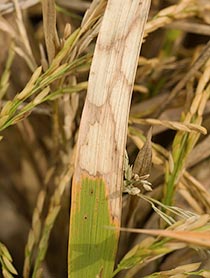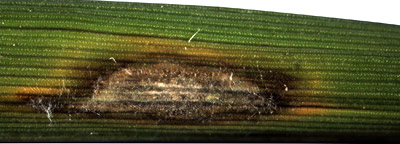
Sheath blight is the most common rice disease in Missouri. The fungus overwinters in the soil; in warmer weather, its spores float in floodwater and attach to rice stems. Infection starts just above the waterline, causing gray oval lesions with purple borders. Figure 1 shows typical sheath blight leaf symptoms.
Control the disease by planting resistant rice varieties and avoiding high plant populations and excessive nitrogen. Applying strobilurin fungicides also can reduce or prevent infection. Go to “Rice Sheath Blight Control” for more information on rice sheath blight.
Brown spot is the second-most common rice disease. Spots are small to oval in shape. The disease favors stressed plants; infected plants are often potassium deficient. Brown spot worsens with heavy dew and light rainfall. While this disease can look severe, it causes little yield damage. Applying strobilurin fungicides can reduce infection, though any hidden nutrient deficiencies accompanying the disease will still cause yield reductions.
Blast is less common than sheath blight or brown spot, but more devastating when it occurs. Spores are transported north by the wind. Its symptoms are diamond- or eye-shaped lesions on leaves and dead panicle necks (Figure 2).

Plant early to avoid late-season pressure. Plant resistant varieties and maintain 4-inch or deeper floodwater. Apply strobilurin fungicides at boot stage as a preventive measure. Go to “Rice Blast Control” for more information on rice blast.
Kernel and false smut are a problem in some rice fields, but they generally do not cause damage to yield. They can, however, affect grain quality. Applying fungicides can help prevent infection.